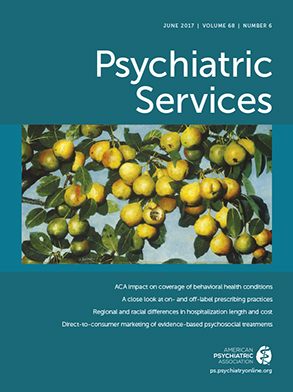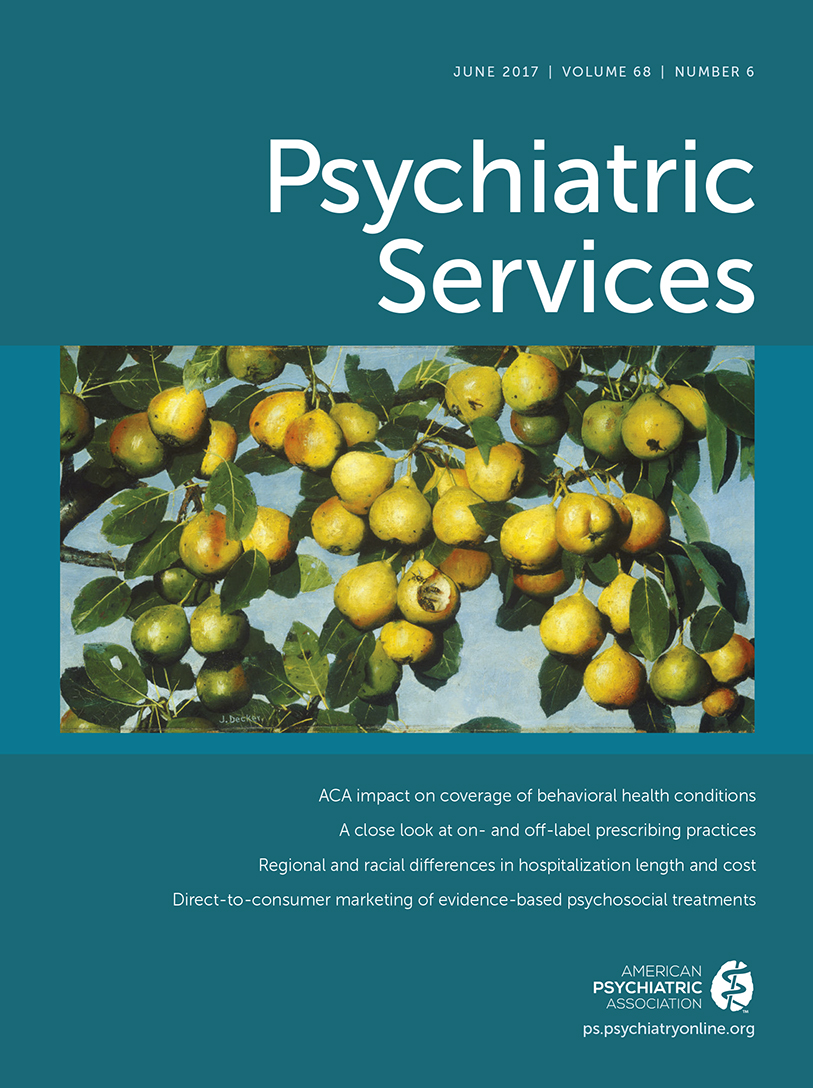Substance use commonly co-occurs with posttraumatic stress disorder (PTSD), and veterans with co-occurring PTSD and substance use disorders often present with more clinical and psychosocial difficulties compared with veterans with PTSD only (
1). Veterans Health Administration (VHA) practice guidelines recommend coordinated treatment for co-occurring PTSD and substance use disorders. However, substance use disorders may inhibit access to PTSD specialty care programs, which are an important part of the continuum of care for PTSD within VHA. Veterans who are diagnosed and treated in PTSD specialty programs typically receive more sessions of psychotherapy than veterans who are treated in other settings (
2). Also, given that VHA has prioritized the training of PTSD specialty program clinicians in evidence-based psychotherapies for PTSD (
3), specialty programs likely have greater expertise in effectively treating PTSD.
Access to VHA mental health care for veterans with co-occurring disorders is a concern. For example, outpatient PTSD specialty programs may exclude veterans who appear too unstable for active treatment (
4), and inpatient PTSD programs may prefer abstinence upon admission. Once accepted for treatment, individuals with a substance use disorder might have greater difficulties attending and complying with a course of psychotherapy for PTSD (
5). Thus providers might exclude veterans with substance use disorders from PTSD treatment, preferring that the individuals complete substance use treatment or achieve abstinence before initiating PTSD treatment (
1). Currently, it is unknown how co-occurring substance use disorders affect receipt of PTSD treatment among veterans.
We used a retrospective design to determine whether a co-occurring substance-related diagnosis hindered access to PTSD-related care among VHA veterans during a one-year interval. We examined three outcomes: receipt of outpatient care from a PTSD specialty clinic or provider, treatment in specialized residential inpatient PTSD programs, and completion of at least eight sessions of psychotherapy within 14 weeks in any outpatient setting by veterans with an active PTSD diagnosis recorded in the chart. Eight sessions is regarded as the number required to deliver an evidence-based psychotherapy for PTSD and has been used as a proxy for adequate therapy in previous VHA research (
2). Although this outcome does not necessarily indicate receipt of an evidence-based treatment, it represents a substantial dose of care.
Methods
The sample included records from the U.S. Department of Veterans Affairs (VA) Corporate Data Warehouse (CDW) for veterans who were assigned a primary diagnosis of PTSD (excluding visits solely to assess VA compensation and pension benefits) for two different VHA encounters (confirmed PTSD diagnosis) between fiscal years 2009 and 2010 (N=424,211). A co-occurring substance-related disorder was determined by the presence of two or more encounters with a primary or secondary
ICD-9 diagnosis of a substance use disorder involving the same substance, excluding remission codes (confirmed substance use diagnosis). Three distinct groups of co-occurring substance-related disorders—alcohol only, drug only, and alcohol and drug—were defined. [A table listing
ICD-9 substance use disorder diagnostic codes used for this study is provided in the
online supplement to this report.] We used home zip code to assign median household income (
6) and distance to the nearest VHA point of service.
Among veterans in our sample with outpatient PTSD encounters (N=424,107), we identified PTSD specialty care by using VHA clinic stop codes for a PTSD specialty clinic or specialist or a combined PTSD and substance use specialty clinic (
2). Veterans with inpatient PTSD admissions (N=16,150) were identified by using bed section codes for PTSD specialty care [see
online supplement for a table listing clinic stop codes and bed section codes] (
7). To examine psychotherapy sessions with an active PTSD diagnosis, we first identified veterans in our sample who had two or more primary PTSD outpatient encounters within 90 days during the study period, with at least one encounter at an outpatient mental health clinic, including a PTSD specialty clinic (N=354,991). We then determined which of these veterans received eight or more psychotherapy sessions in any setting within any 14-week period in the year after—or in the 14 weeks before—the second of the two qualifying encounters. PTSD could be listed as either the primary presenting diagnosis or as one of several diagnoses warranting psychotherapy. [Current procedural terminology codes used to identify psychotherapy sessions are provided in the
online supplement.]
We employed logistic regression to estimate the odds of receiving PTSD specialty care in the year following the veterans’ second PTSD encounter and the odds of receiving eight or more psychotherapy sessions within a 14-week period as a function of co-occurring substance use disorder status. All models also controlled for factors that predicted PTSD treatment utilization in prior research (
2,
8) and included gender, age, race, ethnicity, marital status, service era, income, distance to the nearest VHA point of service, and percentage of PTSD outpatient encounters received during the study at a VHA medical center rather than a VA community-based clinic or other VA outpatient location.
A 95% confidence interval (CI) was calculated for all statistics, and data analyses were conducted by using SAS software, version 9.4. The institutional review boards at the VA Pacific Islands Health Care System and Stanford University approved the study protocol and waived the requirement for informed consent.
Results
The prevalence of a co-occurring substance use disorder diagnosis in the sample was 16% (N=67,717). All but 104 veterans had at least one outpatient PTSD visit in the year following the veterans’ second PTSD encounter. The percentage of veterans with an outpatient PTSD visit who received PTSD specialty care during the follow-up year was higher among veterans with a co-occurring substance use disorder diagnosis (43%, CI=38%−48%) compared with those without a co-occurring substance use disorder diagnosis (38%, CI=36%−40%). Multivariate models, controlling for sociodemographic factors, showed that a diagnosis of a co-occurring substance use disorder was associated with increased odds of receiving outpatient PTSD specialty care (
Table 1). Odds of receiving outpatient PTSD specialty care were also associated with being male, younger, nonwhite or of unreported race, Hispanic/Latino, and married; having served in Operation Enduring Freedom/Operation Iraqi Freedom or in another service era other than the Vietnam era; having an above-median income versus unknown income; living closer to a VHA point of service; and receiving most outpatient PTSD care at a VHA medical center rather than a VHA clinic located elsewhere.
In contrast, veterans diagnosed with a co-occurring substance use disorder were less likely to be admitted to a PTSD specialty program for their inpatient PTSD treatment in the year following their second PTSD encounter (
Table 1). The likelihood of receiving inpatient PTSD care in a PTSD specialty unit was significantly greater among veterans who were male, non-Hispanic/Latino, and married or of unknown marital status; veterans who served in the Vietnam era versus other eras; veterans with an above-median income; and veterans who resided an unknown distance from the nearest VA point of service.
Veterans with co-occurring substance use disorders were almost twice as likely (24%, CI=20%−28%) as veterans with PTSD alone (13%, CI=11%−15%) to complete eight or more sessions of outpatient psychotherapy within 14 weeks. Other characteristics associated with increased odds of completing eight or more psychotherapy visits were being female, older, nonwhite, and married; serving in the Vietnam era; living closer to a VHA point of service; and receiving most outpatient PTSD care at a VHA medical center.
Discussion
Contrary to our predictions, veterans with PTSD and a co-occurring substance use disorder diagnosis were more likely to access PTSD specialty services for outpatient PTSD care compared with their counterparts without a co-occurring substance use disorder diagnosis. They were also more likely to receive at least an eight-session dose of psychotherapy within a 14-week period. VHA has made efforts to support coordinated care for both disorders (
3). Perhaps as a result, co-occurring substance use disorders do not appear to be a barrier to outpatient PTSD care among veterans seeking treatment within VHA.
The finding that veterans with co-occurring substance use disorder diagnoses were less likely than veterans with PTSD only to be admitted to inpatient PTSD specialty units may reflect the fact that such programs—in an effort to balance individual patient needs with program safety, security, and integrity—may prefer abstinence prior to admission (
1). Intensive PTSD programs are not designed for active substance users. However, these controlled environments can help veterans with a history of substance use maintain abstinence and thereby also reduce their PTSD symptoms (
9).
That veterans with PTSD and a substance use disorder diagnosis were more likely than veterans with PTSD only to complete at least eight sessions of outpatient psychotherapy runs contrary to conventional wisdom and some prior research (
5). Veterans with PTSD and a substance use disorder received their treatment from a combination of different clinics, including substance use, mental health, and PTSD specialty clinics. We did not attempt to determine the exact nature, sequencing, or coordination of these treatment services.
It is encouraging that many veterans with PTSD and co-occurring substance use disorders are accessing PTSD specialty treatment, although more than half of the veterans in our sample with a substance use disorder diagnosis did not receive PTSD specialty care. There is no consensus about what types of treatment are best for these co-occurring disorders (
10). Emerging evidence suggests that trauma-focused psychotherapies, which are first-line treatments for PTSD, can be effective among veterans with co-occurring substance use disorders (
11). Little research has looked at the effects of parallel treatment of PTSD and substance use disorders by different providers.
This study had several limitations. Our sample included only veterans who were enrolled as VHA veterans. We could assess dose of care but not the specific focus, sequencing, or quality of treatment. Diagnostic codes are imperfect indicators of substance use status. In particular, we could not differentiate between acute intoxication and dependence, which may need immediate attention, and lower grade misuse, which can be addressed concurrently with PTSD treatment. Similarly, we could not discern PTSD severity or symptom acuity. Because PTSD is comorbid with several serious mental health problems, veterans identified as having PTSD and receiving psychotherapy may not have been receiving PTSD-related psychotherapy. Finally, requiring two encounters with a primary PTSD diagnosis for study inclusion increased specificity (
12,
13) yet possibly excluded veterans with PTSD who either sought treatment sporadically or for whom PTSD was not coded as the primary reason for their encounters.
Conclusions
Our findings suggest that a substance-related diagnosis was not a barrier to accessing specialized outpatient PTSD services among veterans with PTSD. This may reflect VHA’s recent efforts to ensure coordinated and inclusive care for veterans with co-occurring mental and substance-related disorders, including appointing local coordinators to integrate PTSD and substance use treatment. Centralized support for these coordinators was initiated just prior to the start of our analysis, however, and may have had minimal implementation at many facilities over portions of our study period. Our results may also indicate that veterans with a greater number of comorbidities—and potentially a greater treatment need—receive more intensive outpatient treatment. The fact that clinicians often treat veterans with both PTSD and substance use disorders raises questions about the best treatment approaches. Future research should focus on the effectiveness of specific treatment modalities, including how to best match treatments to veterans’ current stage of substance use recovery.

